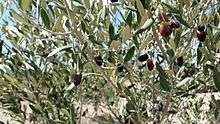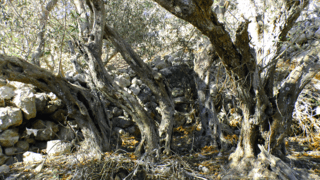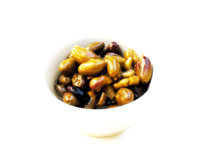Bidni
The Bidni, which is also referred to as Bitni, is an olive cultivar from the Mediterranean island of Malta. The fruit is small in size, hearty with a "violet colour",[1] and is renowned for its superior oil which is low in acidity.[2] The latter is generally attributed to the poor quality alkaline soil found on the Maltese Islands.[3] As an indigenous olive cultivar, the Bidni has developed a unique DNA profile,[4] and is believed to be among the most ancient species on the island,[5] triggering local authorities to declare some of these ancient trees as "national monuments",[6] and as having an "Antiquarian Importance",[7] a status which is enjoyed by only a handful of other species.
| Bidni | |
|---|---|
 Clusters of Bidni olives ripening on the tree | |
| Olive (Olea europaea) | |
| Color of the ripe fruit | Black |
| Origin | Malta |
| Use | Oil and table |
| Oil content | Low |
Etymology
According to the "Maltese-English Dictionary",[8] the word "Bidni" is derived from "badan", which means "corpulent", "robust", "to grow stout". Bidni ("żebbuġ", olive), is a "large olive tree producing very small olives". Therefore, the tree is called Bidni because it is "corpulent". This contradicts several online sources that suggest that the word Bidni originated from the rural hamlet of Bidnija,[9] or that the word means "hunchback" in the Maltese language.[10][11]
Characteristics
In a landmark publication entitled, "Cultivation and Diseases of Fruit Trees in the Maltese Islands",[5] John Borg (1922), Professor of Natural History, Superintendent of Agriculture, and founder of the Government's Experimental Farm at Għammieri, described the Bitni as follows:
The tree is a vigorous grower and of strong constitution. The leaves are broad and rather short, of a lively shining green colour on the upper surface. The fruit is very small, nearly elliptical, with a comparatively very small stone, and turns to a beautiful shining dark violet at maturity, which takes place towards the close of October or early in November. It is very rich in oil of excellent quality, but the fruit though very small is often pickled or salted and has a rich flavour free from bitterness. The fruit is produced in clusters, and the production is sometimes astonishing, the tree becoming literally black with fruit. The tree and its fruit are very resistant to disease, the fruit presents also the advantage that it is never attacked by the olive-fly Dacus Oleae and is therefore always allowed to ripen on the tree. This is a variety which seems to be best suited for large plantations, with a view to the production of oil.
— John Borg
Decades later, the Bitni's disease resistant qualities still baffle scientists. Described by the Olive Oil Times as a "peculiar local variety",[12] reports seem to suggest that abnormally high levels of oleuropein, a natural antibiotic produced by the tree to protect its fruit and leaves, may be behind this remarkable characteristic.[13] The Bitni's oil has been described as "spicy" and "peppery", containing "elevated Polyphenols", a characteristic which differentiates it from other oils.[14][15] Once fully established, fruit is produced in abundance, up to 60 kilos per tree.[16]
Protection

The antiquity of Malta's ancient Bidni olive trees has been confirmed through carbon dating.[9] The Bidni olive trees, which have been found to date back to the 1st century A.D.,[17][18] have been protected since 1933,[19] and are also listed in UNESCO's Database of National Cultural Heritage Laws.[20] In 2011, after recognising their historical and landscape value, and in recognition of the fact that "only 20 trees remain from 40 at the beginning of the 20th century",[21] local authorities declared the ancient Bidni olive grove at Bidnija as a Tree Protected Area,[22] under the provisions of a regulation made in 2011.[23] These highly protected Bidni olive trees, measuring between five and eight metres in height, still bear fruit. Although their fruit is too small for harvesting, the ancient Bidni trees are often revered by visitors.[24] Other Bidni olive trees in the vicinity can be found in the private grounds of Qannotta Castle in Wardija.
Since the Government of Malta has recognised the olive tree as forming an integral part of the traditional landscape, heavy pruning, felling, and uprooting of olive trees, including that of the Bidni variety, is subject to a permit from the relevant authorities.[25]
Although the Bidni olive has no PDO status, there are a number of initiatives, which include studies on its genetic composition,[26] to attain this certification. Apart from legally protecting its name, this status of authenticity is typically used by marketing professionals to gain a competitive advantage at both European and international markets.[27]
Revival
In January 2006, the Project for the Revival of the Indigenous Maltese Olive (PRIMO), was launched.[28][29] Apart from reviving indigenous cultivars, such as the Bidni, one of the aims of this project was to substantially increase production levels in a bid to obtain the much coveted PDO status.[9] As a direct result of PRIMO, some 30,000 Bidni olive trees were grafted and planted, thereby setting the necessary groundwork for the creation of a niche industry.[30] The methodology behind this process consisted of several steps. After olive pips were collected from the ancient Bidni olive grove of Bidnija, these were then sowed at the Government of Malta's Experimental Farm in Għammieri and left to germinate for use as rootstock. Once the rootstocks were viable, cuttings were then taken from the millennia-old Bidni olive trees and carefully grafted to the rootstocks.[31] Efforts to plant more Bidni olive trees are ongoing.[32]
Gastronomy

The Maltese use their olive oil quite generously. In 2012, they ranked 8th in the world in per capita olive oil consumption.[33] With olive oil processing equipment dating back to the Roman Empire, and possibly even before this period,[34] the consumption of oil has since become an integral part of the Maltese diet. For instance, in 1804, French writer Louis de Boisgelin noted that, "a clove of garlic, or an onion, anchovies dipped in oil, and salted fish", was the "usual diet" of the Maltese.[35] Nowadays, the use of oil in Maltese cuisine is still predominant. The popular Maltese snack "ħobż biż-żejt", which literally translates to "bread with oil", is testimony to this.
Although the Bidni is mostly known for its superior oil,[5] the small fruit can also be enjoyed as a table olive. One popular method is to crush Bidni olives in garlic-infused extra virgin olive oil, and then eat them with Maltese bread. Another method is to gently fry Bidni olives after preserving them in brine, and then serve them with seasonal herbs such as parsley or mint. The leaves of the Bidni tree have also been used to make tea which is believed to lower high blood pressure. This ancient remedy is "still used in rural communities in Malta".[36]
References
- Blatchly, Richard; Delen, Zeynep; O'Hara, Patricia (2017). The Chemical Story of Olive Oil: From Grove to Table (1st ed.). United Kingdom: Royal Society of Chemistry.
- "Bidni olive". Slow Food. Retrieved March 27, 2019.
- "Pressing matters – olive oil". Gourmet Today. Malta Today. Retrieved 7 May 2016.
- Mazzitelli, O; Calleja, A; Sardella, D; Farrugia, C; Zammit-Mangion, M (2014). "Analysis of the molecular diversity of Olea europaea in the Mediterranean Island of Malta". Genetic Resources and Crop Evolution. 62 (7): 1021–1027. doi:10.1007/s10722-014-0205-3.
- Borg, J. (1922). Cultivation and Diseases of Fruit Trees in the Maltese Islands. Malta: Government Printing Office.
- "Iż-Żebbuġ tal-Bidnija (l/o Mosta) – Tree Protected Areas". Times of Malta. Retrieved 8 May 2016.
- "Iż-Żebbuġ tal-Bidnija". Malta Environment & Planning Authority. Archived from the original on 12 October 2016. Retrieved 8 May 2016.
- Aquilina, J. (1987). Maltese–English Dictionary. Malta: Midsea Books Ltd.
- "2,000-year-old Trees still producing olives". The Malta Independent. Retrieved 14 May 2016.
- "Olives grow again on Malta". Arab News. Retrieved 14 May 2016.
- "Mission to revive Malta's olive oil production". Yahoo! News. Retrieved 14 May 2016.
- Squadrilli, L. "An Olive Grove in Malta". Olive Oil Times. Retrieved 10 May 2016. Cite magazine requires
|magazine=(help) - Fenecg, N. "Local olive oil 'in demand' abroad". Times of Malta. Retrieved 10 May 2016.
- Cassar, D. "Why do Maltese olives make some of the best olive oils?". TVM. Retrieved 16 July 2019. Cite magazine requires
|magazine=(help) - Starnes, A. "From cheese to olive oil, Malta's foodie scene is on the rise". Cambridgeshire News. Retrieved 22 January 2020. Cite magazine requires
|magazine=(help) - Farrugia Radon, S. (2016). Il-Biedja f'Malta. Best Print. ISBN 978-99957-1-005-7.
- "Race to save endemic olive tree intensifies". The Times of Malta. Retrieved 10 August 2016.
- Cassar, George (2015). "Roman Times (218 BC – 4th century AD)" (PDF). What they ate: food and foodways in Mdina and beyond From Roman times to the Middle Ages. Heland Project. pp. 1–12. ISBN 978-99957-886-3-6.
- "List of Historical Trees Having an Antiquarian Importance". Government of Malta. Retrieved 2 July 2018.
- "List of Historical Trees Having an Antiquarian Importance". UNESCO. Retrieved 14 May 2016.
- "Rural Development Programme for Malta 2007-2013" (PDF). Ministry for Resources and Rural Affairs. 2009. Retrieved 10 May 2016. Cite magazine requires
|magazine=(help) - "Malta Environment and Planning Authority, 2011" (PDF). The Government of Malta Gazette. 2011. Retrieved 3 July 2018. Cite magazine requires
|magazine=(help) - "Trees and Woodlands Protection Regulations, 2011". The Government of Malta Gazette. 2011. Retrieved 10 May 2016. Cite magazine requires
|magazine=(help) - "The White Olives of Malta" (PDF). Aramco World. July–August 2017. Retrieved 3 July 2018.
- "Legislation under Environment Protection Act (CAP 549)". The Environment and Resources Authority. Retrieved January 21, 2019.
- Calleja, A; Farrugia, C; Zammit-Mangion, M (2015). "Genetic Analysis Using DNA Molecular Markers of the 'Malti' Olive Variety Found on the Maltese Islands" (PDF). University of Malta. Retrieved 14 May 2016. Cite journal requires
|journal=(help) - "Istrian EVOO Awaits PDO Status at EU Level". Olive Oil Times. Cite magazine requires
|magazine=(help) - "Olive tree project takes root". Times of Malta. Retrieved 21 May 2016.
- "First 340 indigenous Maltese olive trees planted [Press Release No. 0724]". Department of Information, Government of Malta. Retrieved 6 July 2018. Cite magazine requires
|magazine=(help) - "National Agricultural Policy for the Maltese Islands 2018–2028" (PDF). Pieta`, Malta: Atriga Consulting Services Ltd. Cite magazine requires
|magazine=(help) - Vella, S. S. (2010). "Sustainable Agricultural Management and Landscaping through Agroforestry and Permaculture. Case Study: Northern Malta". James Madison University. Retrieved 6 July 2018. Cite magazine requires
|magazine=(help) - "It's pure Maltese: olive oil from endemic trees". Times of Malta. Retrieved 19 July 2019.
- "Greeks Still World's Top Olive Oil Guzzlers". Olive Oil Times. Retrieved 14 May 2016. Cite magazine requires
|magazine=(help) - Docter, R.; Vella, N.; Cutajar, C; Bonanno, A; Pace, A (2012). "Rural Malta: first results of the joint Belgo-Maltese survey project" (PDF). Babesch. 87: 107–149. doi:10.2143/BAB.87.0.2160694. Retrieved 22 May 2016.
- de Boisgelin, Louis (1804). Ancient and Modern Malta. London: G & J Robinson.
- Cremona, M. (2002). Cooking with Maltese Olive Oil – Maltese and Mediterranean Dishes. Malta: Proximus PR.